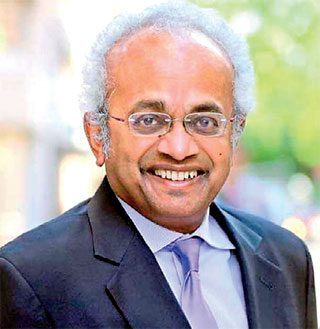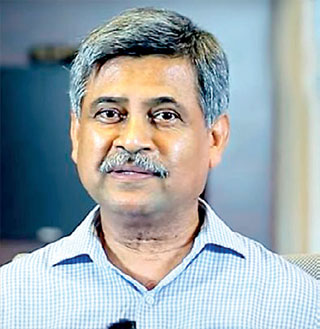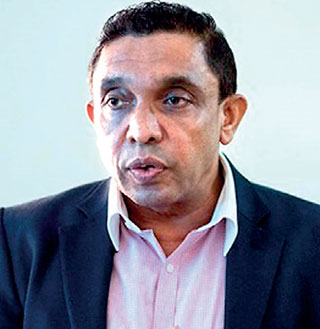Tuesday Dec 23, 2025
Tuesday Dec 23, 2025
Wednesday, 31 August 2022 00:00 - - {{hitsCtrl.values.hits}}

Prof. Shanta Devarajan

Hema Senanayake

Prof. Sirimal Abeyratne
This article is based on the views expressed during the online seminar organised by the Sri Lanka Economic Association (SLEA), on 27 August, as a part of its monthly seminar series. Prof. Shanta Devarajan, a Professor of the Practice of International Development at Georgetown University’s Edmund A. Walsh School of Foreign Service presented his views on ‘Economic Reforms in Sri Lanka and Aragalaya’. The discussant of the seminar was Hema Senanayake, a PhD candidate in Economics at University of Colombo. And the seminar was moderated by Prof. Sirimal Abeyratne, a Professor in Economics at University of Colombo.
Sri Lankans are struggling with shortages of food, fuel, medicines, and fertiliser as the country is experiencing its worst economic crisis since independence. The economy is expected to decline by 8% this year. Inflation is above 50%, with food inflation exceeding 80%, which is an unprecedented level of inflation. On the other hand, the people’s movement (“Aragalaya”) toppled a democratically elected president for the first time in Sri Lanka’s history.
The proximate causes of the current crisis were:
1. The tax cuts of 2019 (VAT rate reduced from 15 to 8%) which caused the fiscal deficit to balloon.
2. In 2020, credit agencies downgraded Sri Lanka to near default level, cutting off access to capital markets.
3. The Government refused to seek a program with the IMF and negotiate a debt restructuring with creditors. Instead, the Government continued to repay creditors out of its reserves, leading to depletion of reserves by 2022. And it financed fiscal deficit by printing money, leading to inflation.
How did this happen despite Sri Lanka being a moderately successful economy, with enviable human development indicators and uninterrupted democracy since independence?
The Aragalaya movement put the blame on the dire economic circumstances squarely on the Rajapaksa Government, implicitly supporting the reversal of policies. It called for the accountability of Government and the empowerment of the poor.
Economic policies in the country since the 1950s have, even if well-intentioned, weakened accountability of Government to citizens, leading to elite capture and disempowerment of the poor. This is exactly what the Aragalaya is fighting against. Six main cases can be identified.
1. Fuel and electricity subsidies
Fuel and electricity subsidies’ benefits accrue to the rich. Thus, it is a form of elite capture. These also contribute to fiscal deficit (which has caused high inflation—a tax on the poor). Replacing them with targeted cash transfers to the bottom 40% will save money and help the poor. Eliminating subsidy makes the utility (the CEB) accountable to citizens, not to politicians. Subsidies force poor people to consume fuel to get a benefit; cash transfers, on the other hand, allow them to spend on what they want.
2. Targeted cash transfers
The Samurdhi Program is the largest social transfer programme in Sri Lanka. This program suffers from huge errors of inclusion and exclusion in targeting. Evidence of political capture of the program has been found. However, it is possible to reform the targeting of assistance.
3. Education
The free education system in Sri Lanka is successful in enrolments, which is the main indicator used to measure its success. However, there are problems with its quality. The average pass rate of Mathematics, Science and English in Grade 8 was around 50% (in 2012), and a high level of teacher absenteeism has been documented. The so-called free education system has problems with targeting the poor. A very high incidence of private tuition can be observed around the country. The same teacher who is not accountable in public school is accountable in private setting. And only the rich can afford private tuition. In Sri Lanka, although there is parity between rich and poor in primary and secondary education, the parity is lost in higher education. 50% of those benefiting from public tertiary education come from the richest quintile and 70% from the richest two quintiles.
4. Employment
Trade liberalisation in Sri Lanka was a success since it had a strong human capital base. However, its industry employment did not grow as fast. This was due Sri Lanka’s restrictive labour regulations. The generous severance pay made employers reluctant to expand employment. Amidst this stagnation, fearing the youth bulge, the Government started hiring workers in the public sector. This made these workers accountable to government rather than the other way around. Government salaries, including benefits, are higher than private salaries. If the risk premium, that one cannot be fired from the public sector, is also considered the salaries in the public sector are much higher than in the private sector.
This explains why graduates have high unemployment rates; they are waiting in the queue to get a plum government job. The Government hiring policy raises the reservation wage of working in the private sector, making it harder for the private sector to be competitive. Thus, it is not a surprise that the private sector is not expanding employment. On the other hand, since even the public sector jobs were not enough, some Sri Lankans went to the Middle East as migrant workers.
5. Agriculture
Economic boom after trade liberalisation hid the fact that the agriculture sector was still lagging. Agricultural policy geared towards disempowering poor farmers, especially paddy farmers. The Paddy Lands Act requires farmers to grow paddy, which is not the most lucrative crop. They will be fined if they grow other cash crops. Farmers are also unable to lease land or sell it.
6. Fiscal and Monetary Policy
Sri Lanka has the highest inflation in South Asia. The fiscal deficit being financed by borrowing from the Central Bank is the main reason for this. This fiscal dominance has led the country to have the highest inflation amongst its South Asian peers over the years. Inflation is a tax on the poor. The other two ways of financing fiscal deficit are borrowing domestically and abroad. Borrowing domestically increases domestic interest rates with political repercussions, and the non-poor will be affected. Borrowing abroad makes government accountable to external creditors. Thus, this fiscal dominance has led to the least accountable way of financing the fiscal deficit. This is the reason why Government has resisted the Central Bank independence.
On the other hand, external borrowing is two-fold: public vs. private creditors. Private creditors only look at economic performance; thus, the government is held accountable. Public creditors can cut deals with Government for questionable projects and thus the government is not accountable. Therefore, when credit agencies downgraded Sri Lanka to near-default status, it was important to restructure debt and resume private capital market access. Instead, the Government chose to try to get some deals from official creditors.
Conclusion
The current economic crisis is not just due to policy missteps by the Gotabaya Rajapaksa administration but the culmination of a series of economic policies that have undermined Government accountability, facilitated elite capture, and disempowered the poor. These policies have persisted because of good luck and complacency from some successes. In 2022, this luck ran out and the accountability failures became glaringly evident. The good news is that the reforms needed to emerge from the crisis (like subsidy reforms) are also reforms that can strengthen accountability, reduce elite capture, and improve the welfare of the poor. The Aragalaya movement, in its call for greater accountability and the empowerment of the poor, is therefore complementary to the Sri Lankan reform program.
(The writer is a Committee Member of the SLEA Council of Management 2022-2023. She is also a Lecturer (Probationary) in Economics.)